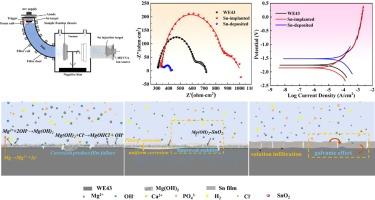当前位置:
X-MOL 学术
›
Appl. Surf. Sci.
›
论文详情
Our official English website, www.x-mol.net, welcomes your
feedback! (Note: you will need to create a separate account there.)
Different corrosion behaviors of Sn-based modification coatings on magnesium alloy surface via plasma-involved processes: FCVA deposition vs MEVVA ion implantation
Applied Surface Science ( IF 6.3 ) Pub Date : 2024-11-18 , DOI: 10.1016/j.apsusc.2024.161842 Liping Guo, Xinxuan Wang, Liwei Lu, Hongshuai Cao, Yilong Dai, Kaiwei Tang, Nie Zhao, Fugang Qi, Xiaoping Ouyang
Applied Surface Science ( IF 6.3 ) Pub Date : 2024-11-18 , DOI: 10.1016/j.apsusc.2024.161842 Liping Guo, Xinxuan Wang, Liwei Lu, Hongshuai Cao, Yilong Dai, Kaiwei Tang, Nie Zhao, Fugang Qi, Xiaoping Ouyang

|
In this work, the surface of WE43 was modified with Sn ions using a composite device with both filtered cathode vacuum arc (FCVA) and metal vapor vacuum arc (MEVVA) functions. The influences of Sn ions on the surface morphology, elasticity modulus (EIT), nano-hardness (HIT), and corrosion resistance of WE43 after modification by different treatments were comparatively studied. The corrosion mechanism was also elaborated from the perspectives of corrosion kinetics and oxidation process. The results proved that the modulus of elasticity of the samples increased after the Sn ion modification of WE43 by both FCVA and MEVVA, in which the EIT increased from 55.24 to 57.04 GPa after FCVA modification. The FCVA technique covered the surface of the samples with a uniform Sn film, however, the difference in potential between Sn and Mg was too large which aggravated the galvanic coupling corrosion. After the injection of Sn ions, a modified layer consisting of SnO2 and Sn was successfully formed on the sample face. The electrochemically measured Icorr of WE43, Sn-implanted and Sn-deposited were 23.15, 17.88 and 65.25 μA⋅cm−2 . The results of the immersion experiments demonstrated that SnO2 effectively impeded the dissolution of Mg (OH)2 , resulting in the formation of a uniform and dense corrosion product film that enhanced the corrosion resistance of WE43.
中文翻译:

Sn 基改性涂层通过等离子体参与过程对镁合金表面的不同腐蚀行为:FCVA 沉积与 MEVVA 离子注入
在这项工作中,使用具有过滤阴极真空电弧 (FCVA) 和金属蒸气真空电弧 (MEVVA) 功能的复合器件用 Sn 离子修饰 WE43 的表面。对比研究了 Sn 离子对不同处理改性后 WE43 表面形貌、弹性模量 (EIT)、纳米硬度 (HIT) 和耐腐蚀性的影响。从腐蚀动力学和氧化过程的角度阐述了腐蚀机理。结果表明,FCVA 和 MEVVA 对 WE43 进行 Sn 离子改性后,样品的弹性模量增加,其中 FCVA 改性后的 EIT 从 55.24 GPa 增加到 57.04 GPa。FCVA 技术用均匀的 Sn 膜覆盖样品表面,然而,Sn 和 Mg 之间的电位差太大,加剧了电偶腐蚀。注入 Sn 离子后,在样品面上成功形成了由 SnO2 和 Sn 组成的改性层。电化学测量的 WE43、Sn 注入和 Sn 沉积的 Icorr 分别为 23.15、17.88 和 65.25 μA⋅cm−2。浸泡实验结果表明,SnO2 有效阻碍了 Mg (OH)2 的溶解,从而形成均匀致密的腐蚀产物膜,增强了 WE43 的耐腐蚀性。
更新日期:2024-11-18
中文翻译:

Sn 基改性涂层通过等离子体参与过程对镁合金表面的不同腐蚀行为:FCVA 沉积与 MEVVA 离子注入
在这项工作中,使用具有过滤阴极真空电弧 (FCVA) 和金属蒸气真空电弧 (MEVVA) 功能的复合器件用 Sn 离子修饰 WE43 的表面。对比研究了 Sn 离子对不同处理改性后 WE43 表面形貌、弹性模量 (EIT)、纳米硬度 (HIT) 和耐腐蚀性的影响。从腐蚀动力学和氧化过程的角度阐述了腐蚀机理。结果表明,FCVA 和 MEVVA 对 WE43 进行 Sn 离子改性后,样品的弹性模量增加,其中 FCVA 改性后的 EIT 从 55.24 GPa 增加到 57.04 GPa。FCVA 技术用均匀的 Sn 膜覆盖样品表面,然而,Sn 和 Mg 之间的电位差太大,加剧了电偶腐蚀。注入 Sn 离子后,在样品面上成功形成了由 SnO2 和 Sn 组成的改性层。电化学测量的 WE43、Sn 注入和 Sn 沉积的 Icorr 分别为 23.15、17.88 和 65.25 μA⋅cm−2。浸泡实验结果表明,SnO2 有效阻碍了 Mg (OH)2 的溶解,从而形成均匀致密的腐蚀产物膜,增强了 WE43 的耐腐蚀性。

































 京公网安备 11010802027423号
京公网安备 11010802027423号